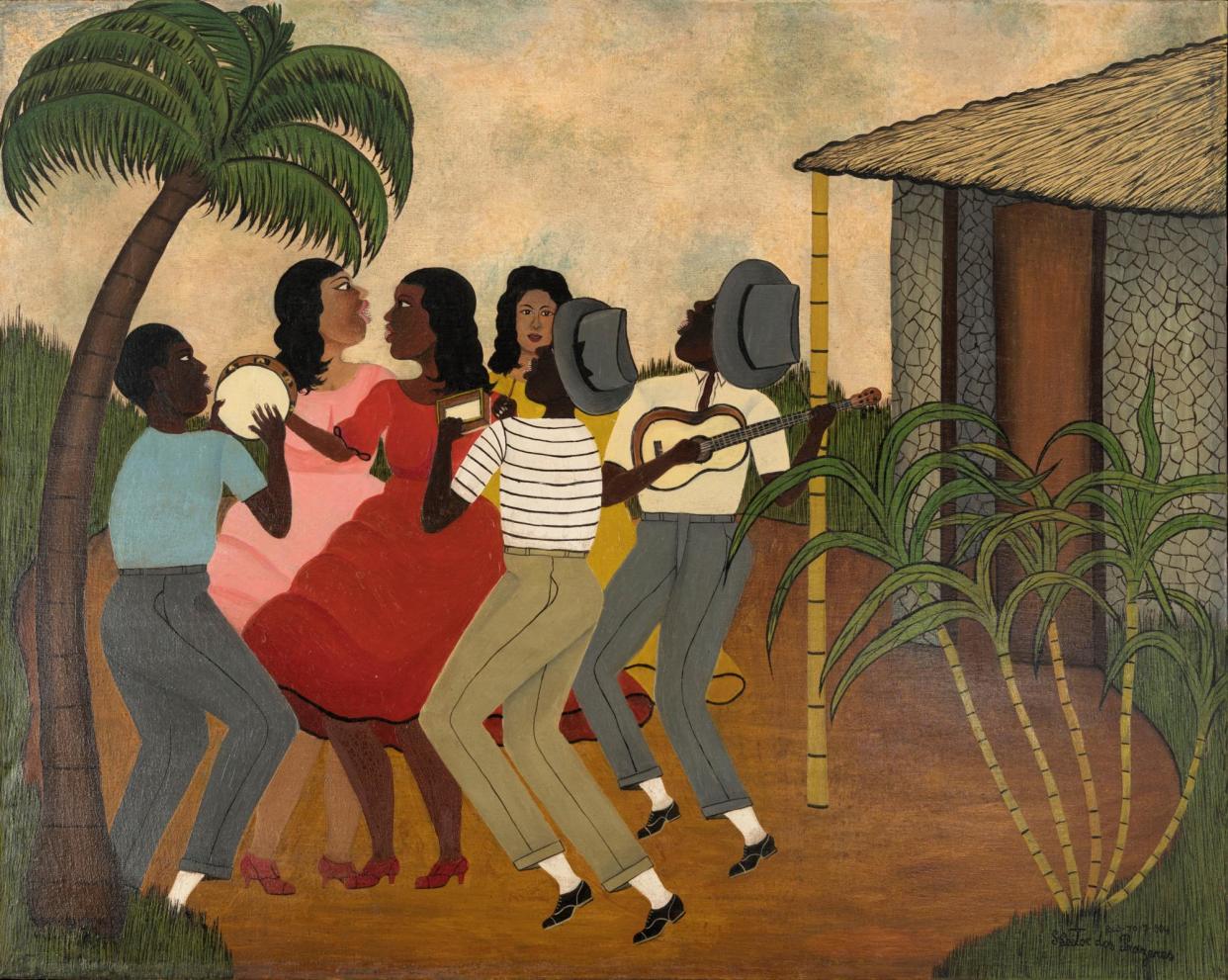Some May Work As Symbols review – this raucous Brazilian art extravaganza can stop you in your tracks

Wild sambas and strict abstractions, vibrating lines and arrangements of eye-popping triangles. Weddings in church and a walk in the park. The rational and the religious, the grid and the carnival collide in Some May Work As Symbols at Raven Row in London. The exhibition shuttles between Rio de Janeiro, São Paulo and Salvador in the state of Bahia, between conflicting ways of looking and thinking and being in the world.
Subtitled Art Made in Brazil 1950s-70s, the exhibition is both tantalising and wonderfully incoherent, jumping from one place and time to another, between the conflicting strains of the local and the international, and the different strands of Brazil’s culture. There’s pleasure in all the variety, the quiet moments and the humour, only some of which is intended. Based largely on the holdings of four Brazilian museum collections, the exhibition revels in its discord. The sculptures of Candomblé priest Mestre Didi meet Bauhaus-inspired constructionism. Rectangles by Hélio Oiticica jostle on flat backgrounds and characterful birds hunt the riverbanks in a tapestry by Madalena Santos Reinbolt. Puckered globs of paint stamp biliously across the surfaces of Zero Group artist Almir Mavignier’s optically and materially disturbing canvases, and a bull’s glowering head has a fish for a nose in one of Abdias do Nascimento’s emblematic paintings.
One minute I am arrested by the phenomenological niceties of two black squares on different coloured grounds by Willys de Castro, the next sucked into the disturbing works of samba musician, furniture and clothes designer and painter Heitor dos Prazeres, whose paintings recur in different rooms. The more I look, the odder these get. Girls in striped dresses dance with parasols on the street, people crowd the favela and play music under a tree. They all wear gorgeous clothes as they dance on their tiny, well-shod feet, but it is the mouths of these people that get me. Seen in profile, Dos Prazeres’s people have serious dental issues, their teeth sticking out as if they had shuttlecocks stuck between their lips. Seen straight on, their mouths are as terrifying as lampreys or B-movie vampires. This sort of thing stops you in your tracks.
We are constantly having to recalibrate as we go from the austere pleasures of the orthogonal and the rational to the folkloric and the fantastical, or from a progression of finely ruled and drawn lines by Judith Lauand to a carved wooden sculpture of a mother and child by Agnaldo Manuel dos Santos, whose art was informed by his African heritage.
Suddenly it’s lunchtime. The kids are noisy at a table of their own and the adults are eating and talking and reaching for dishes. Rich with detail, everything – from the dishes of cutlets and stews to the stuff piling up in the sink, from the bottles of beer to the fruit in the bowl – lurches from the surface in lumpy relief, the oil paint beefed up with plaster and hair. What a delight, and a clamour of the precise and the inept, is this lively 1974 scene, by self-taught painter Maria Auxiliadora. The floor tiles are a mad lattice and the embroidery on the damask tablecloths is picked out precisely.
The conflicts we know best in postwar Brazilian art are those between the different branches of geometric abstraction that flourished after Swiss artist, architect and designer Max Bill showed in Rio in 1950 and at the São Paulo biennial in 1951, and then went on to help set up the Technical School of Creation in Rio, whose ideas were distilled from futurism, de Stijl and the Bauhaus. Bill’s approach impressed Brazil’s then president, Juscelino Kubitschek, in his drive to modernise the country through industrial development and the creation of liberal democracy – based, according to curators Pablo Lafuente and Thiago de Paula Souza, on positivist rational principles, which Bill’s work exemplified.
The subsequent developments and rifts within geometric abstraction as it developed in 1950s Brazil probably don’t bother anyone now as once they did. One of the pleasures among the collection of historical essays in the small catalogue accompanying the show is a 1967 text by critic Frederico Morais, pungently titled Concretism/Neo-concretism: Who Is, Who Isn’t, Who Joined, Who Preceded, Who Touched Upon, Who Remained, Left, Returned, Did Concretism Exist? The title alone says it all.
There is some great abstract art here, all of it having a life of its own. Much of it looks as fresh as it did 50 or 60 years ago. We look at it differently now, of course, less burdened by its purities. Some May Work As Symbols is a glimpse of a complex social and cultural situation, and presents a kind of corrective to stereotyped potted histories of postwar Brazilian art. It is filled with surprises, with the everyday, the utopian and the conflicted. Two serpents coil from a palm, in one of Didi’s sculptures, while nearby, a mute disc, by Lygia Clark, hangs from the wall, like some kind of industrially fabricated eclipse. Maybe their proximity is more than happenstance.
Some May Work As Symbols: Art Made in Brazil, 1950s-70s is at Raven Row, London, until 5 May


